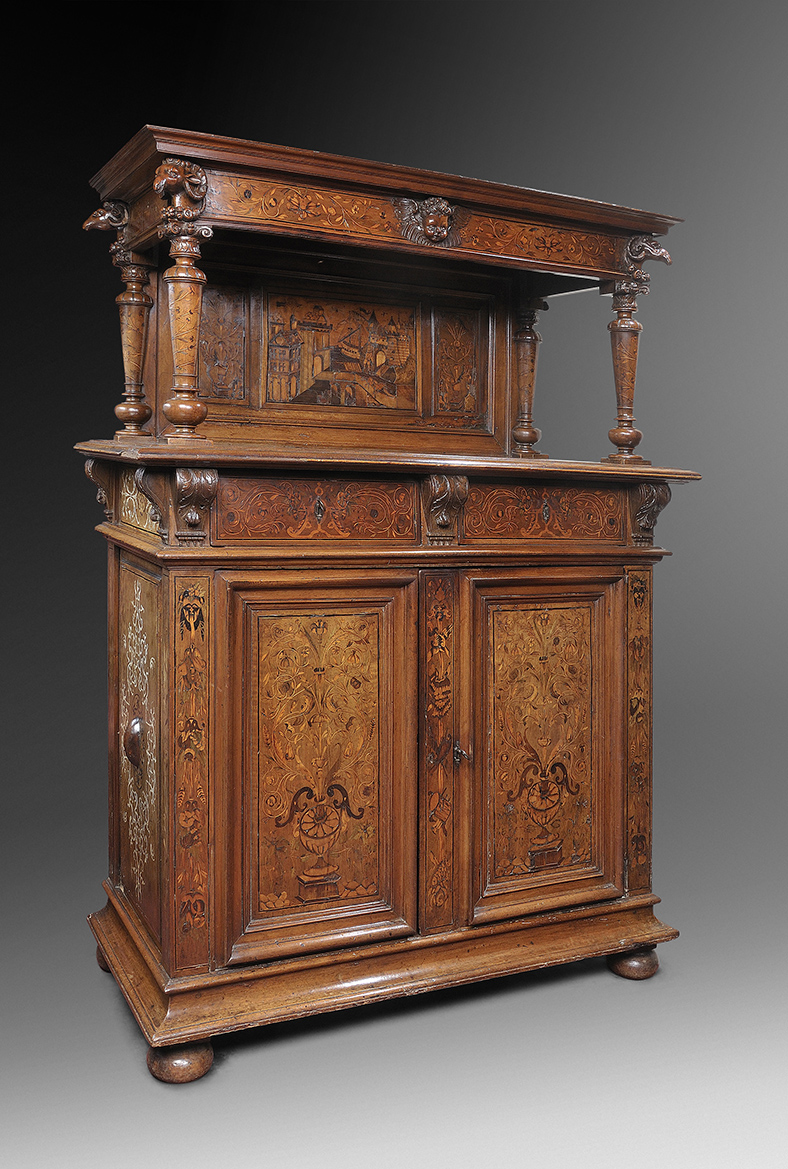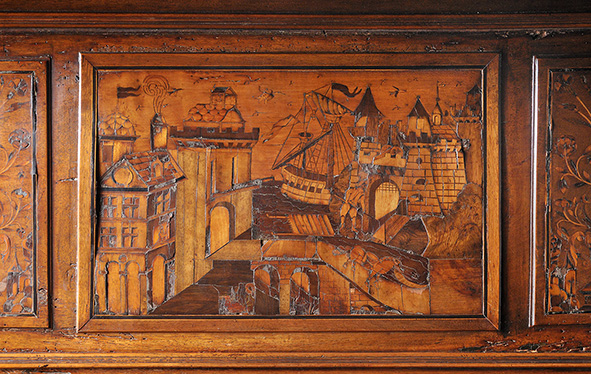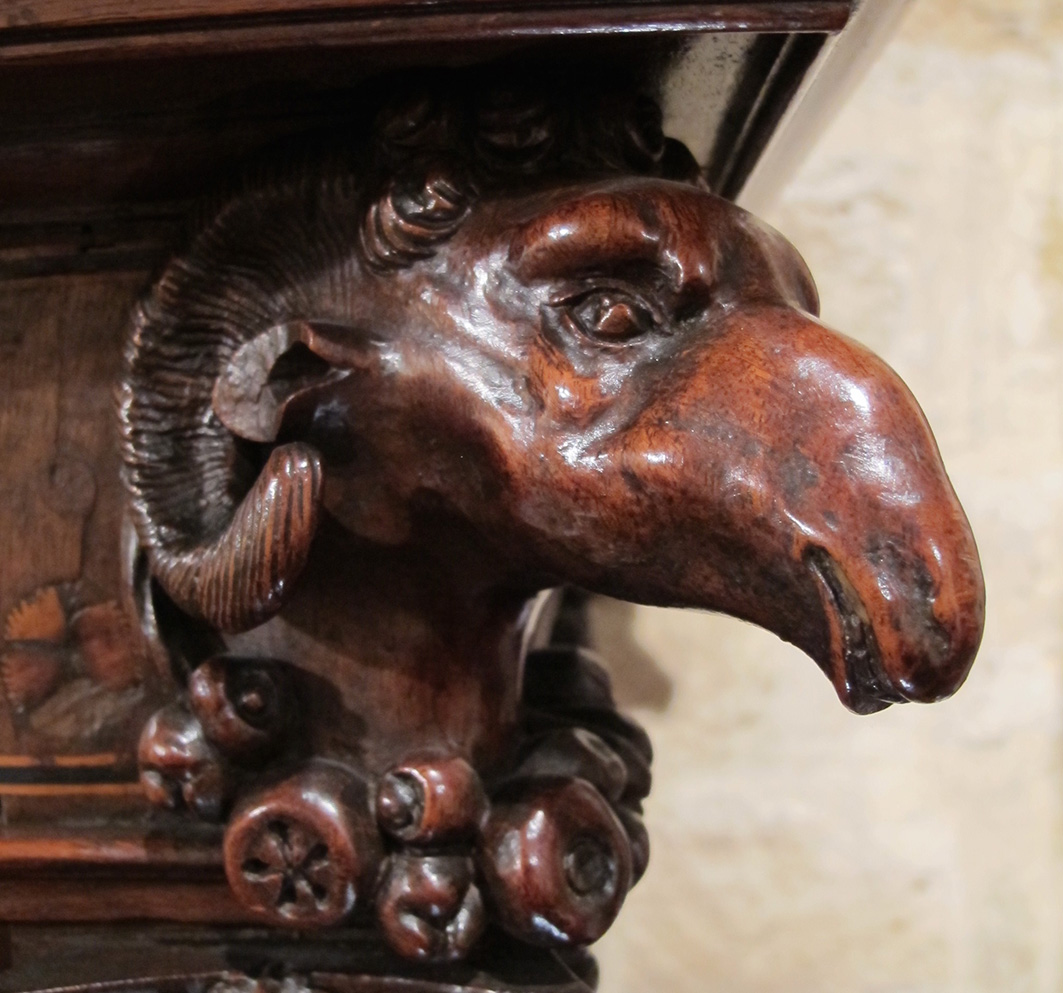Description
This sideboard, with rich marquetry decoration, consists of two parts. The decorated upper body allows for the display of fine silverware. Superb carved rams’ heads emerge from each corner, standing on trays of fruit. Fruits and weapon trophies on both lateral uprights and the casing give the body a ternary rhythm, whereas the two doors depict a fine winding floral pattern, work typical of German artists, who were masters in the field.
The use of different techniques and types of wood combine to create a rare decorative unity of the highest quality, playing with two effects; one being shadow and light and the other being the tones of light and dark wood.
The first effect refers to the carving, sculpture in the round or very high relief, made out of reported elements, and is limited to the upper part of the dresser; consoles of acanthus leaves on the central belt and the balusters. Then on the entablature, there is a winged angel’s face with round cheeks and curly hair, and very elegant rams’ heads.
Such carvings are typical of the French Renaissance style, based on Italian patterns.
The second effect is based on a technique born in Italy, inlaying, becoming marquetry when set into the wood without drilling into the support, like for a veneer leaf. Widely spread, this technique has been reused and developed, especially in Germanic countries, where artists and cabinetmakers became masters in the field.
Their influence is obvious here, whether they carried out or inspired these designs. The decorative compositions from the Welschart ‘Renaissance’ combine the use of a wide variety of wood with contrasting tones, as well as the use of the pastiglia technique, whereby a white paste is applied in furrows hollowed out of the wood. Clear arabesques are organised around a dark mirror on the lateral faces, cornucopias and foliage on the belt, drawers and entablature.
The upper body
The architrave stands on two columns with ionic capitals, turned in baluster and wrapped with a light foliate design in marquetry. It has a frieze inlayed with foliage and at its centre, is a carved winged putti’s head, with curly hair. This architrave bears some finely carved rams’ heads with elongated muzzles, on the front and rear corners.
On the back panel, there is a view with a gated entrance to a city, a castle, a bridge, a house and a boat. This is flanked by two small panels decorated with floral patterns.
On each of these smaller panels is depicted a ewer standing on a mount in a rocky landscape. From the vase emerges an axis from which flowers, roses and columbines grow, ending up in a symmetrical bouquet. On each of the panels, a small church and a house are placed in a way that frames the central scene.
The central panel is reminiscent of the work done by German inlayers, using perspective.
In the foreground, on the left, there is a tall building which consists of a two story house with windows, on top of a gallery with open archways. A chimney, from which smoke escapes, is also depicted in order to emphasise realism.
In the middle-distance is depicted a gate way of a city with a lowered drawbridge, leading onto a bridge and making a path which provides an exit for the horse that walks upon it.
On the right there is a castle built on a rock. It has two entrance towers with crenulations and its lifted portcullis is ready to welcome a halbardier.
In the middle of the background a vessel is depicted, with a mast with folded sails.
The lower body
Standing on flattened round feet, the curved moulded base holds the uprights, decorated with successive falls, fruits (apples/pears) and wheat, crowned by a Venetian mask.
On the central casing the pattern is different. It includes drums, weapon trophies in which we see an antique sword depicted three times, described as a ‘badelaire’ in the 16th century texts.
This piece of furniture opens with two finely and elegantly decorated doors. Flanked by two trees emerging from rocky grounds, a beautiful round cup stands on a square mount. In the centre is placed an axis with three levels. From four levels emerge pairs of stems with beautiful twisted foliate patterns which interlace each other. Fruits, flowers, and ears of wheat appear.Above, the belt is divided by three consoles of acanthus leaves. It opens by two drawers decorated with cornucopia patterns, from which fruits and large curled floral stems emerge. This Alsatian motif which is called Maikrug ‘Rose of May’ Mixes with the omnipresence of the Rollwerk in other words arabesque.
The board, on which the upper body stands, is decorated on three sides with an inlayed frieze, similar to the one depicted on the architrave.
The sides
The sides are filled with wonderful pastiglia work, spread out in a frieze on the belt and in a large grotesque, from which the white-cream colour sparkles on the walnut background.
The artist chisels out the design to be represented in the wood, and then fills the furrow with pastiglia or crushed eggshell mixed with animal glue.
These latteral sides express the influence of Eck Veit, carpenter, cabinet-maker and engraver (d. 1604). This Strasbourg’s statt schreyner (carpenter of the city) published in 1596 his Kunstbüchlein (Book of Art) whith 25 full-page engravings whose purpose is to « deliver the fruit of a long life’s experience by gathering some designs used in the practice of the craft ». A book extremely modern considering that for the first time its author is no longer an artist expressing his theories but a craftman itself. Eck exposed his taste for scrolls networks growing around a central motif, as here the two mirrors. Furthermore the marquetry’s design on the belt’s latteral sides evokes the reuses of ironwork forms much appreciated by cabinetmakers in Alsace such as Eck Veit.
Nevertheless with our sideboard the treatment of the motifs is freer compared to the rigour revealed by Eck. It leads to imagine a later craftman, probably from the 2nd Alsatian Renaissance.
This piece of furniture illustrates the double Italiano-Germanic inspiration, as well as the quality ‘savoir-faire’ both in the carving and the marquetry work.



